Abstract
Aim:
The study aims to find out the prevalence of obesity and its consequences on the health of middle-aged (45–59 years) women in slum areas.
Methodology:
The present study includes 559 women between 45 and 59 years of age from slums of Pune city, Maharashtra. Data were collected using a structured questionnaire, anthropometric measurements, physical activity using International Physical Activity Questionnaire long version, information on dietary habits, chronic illnesses, etc., Univariate analysis and further multiple logistic regressions were used to determine associations and risk estimates using Statistical Package for the Social Science version 16.
Results:
About 60% had body mass index (BMI) above normal, 39% were overweight, and 21.3% obese. The percentage of obesity increased with increasing age. Obesity was significantly associated with working status (P = 0.042), hypertension (P = 0.013), knee pain (P = 0.029), squatting (P = 0.001), walking (P = 0.001), climbing stairs (P = 0.004), and rising from chair (P = 0.040). Functional decline was reported by 62.8% women. Odds of having high blood pressure 1.8 (95% confidence interval [CI]: 1.1–3.0), difficulty in squatting, walking was 1.5 (95% CI: 1.0–2.4) and 1.9 (95% CI: 1.0–3.6) respectively more in overweight. Higher odds of having blood pressure 1.8 (95% CI: 1.0–3.3) and difficulty in walking 2.4 (95% CI: 1.2–4.6) was observed in obese women as compared to women in normal BMI category.
Conclusion:
The study shows that the prevalence of obesity is higher among women even in the low-income areas. This indicates a need for specific interventions targeted to women in urban slum. The inclusion of multicomponent intervention will prove to be beneficial at the community level.
KEYWORDS: Middle-aged, obesity, urban slums
INTRODUCTION
Obesity is a major public health challenge across the globe. Urbanization, economic growth, changing lifestyle and dietary habits have posed a “double burden” of diseases in rapidly developing low- and middle-income countries like India.[1,2] It is well known that availability of high-calorie foods, decreased physical activity and loss of healthy habits are associated with urban living. During the last decade, the percentage of overweight and obesity increased from 12.6 to 20.7 in India.[3] In India, obesity is believed to be a problem of the affluent class and therefore remains neglected in poorer sections. Thus, this study focuses on the prevalence of obesity, lifestyle factors leading to obesity and its health consequences on the life of middle-aged (45–59 years) women in slum areas.
METHODOLOGY
This cross-sectional study was carried out in a low-income area that is in a recognized slum located in one of the randomly selected administrative ward of the city of Pune. The slum is situated in the center of the ward surrounded by high rise buildings. There were about 1200 households in the area. As this is a recognized slum, public sanitation, and water facilities were available in the area. Some houses had private toilets within their blocks. The primary occupations of the people in the area were daily wage labor, but many women were engaged as helper in neighboring shops, restaurants, worked as domestic helper, vegetable vendors, etc. The area is very well connected by the city transport facility, and the residents have easy access to health, educational, and recreational facilities. In the current study, the sample size was calculated using the prevalence of 20.7, confidence level of 95% and a precision of 0.05. This is based on the recent fourth National Family Health Survey (NFHS-4) report; the prevalence of obesity among women in India is 20.7. Thus, the total sample size obtained was 457. Considering 20% nonresponse, a total of 559 women were interviewed. The data were collected using a structured schedule. The schedule included demographic details, anthropometric measurements such as height and weight, tobacco consumption, consumption of vegetables and fruits, fried/outside food, physical activity, chronic disease, and functional limitation. Pretesting of the questionnaire was done among 30 women aged between 45 and 59 years in another ward of Pune city. Women with severe illness, severe disabilities (which restricted their mobility) were excluded from the study. The analysis was done using the Statistical Package for the Social Science version 16, (Chicago, IL). Univariate (Chi-square) was performed to find out the association of obesity with various demographic, chronic diseases, and functional limitation variables. Multiple Logistics regression was used to understand the relationship between the independent variables (modifiable and nonmodifiable risk factors, and other associated factors) and the main dependent variable body mass index (BMI).
Variables
The respondents were categorized according to the WHO international BMI classification:[4] underweight (below 18.5 kg/m2), normal (>18.5–24.99 kg/m2), overweight (25–29.99 kg/m2), and obese (above 30.00 kg/m2). Physical activity was recorded using the International Physical Activity Questionnaire long version (IPAQ). The physical activity was classified into three groups: low-level physical activity (<600 Metabolic Equivalents (METs)), moderate level physical activity (600–3000 METs), and vigorous level physical activity (>3000 METs). Questions regarding the presence of chronic diseases were asked. Functional decline was assessed using the Pune-FAAT [5] tool which comprised of 10 activities of daily living items such as lifting weight, bending, squatting, walking, climbing up stairs, rising from chair, self-cleaning, toilet use, dressing, and eating food. The study followed all the ethical guidelines prescribed for an observational study. Informed consent was taken from each respondent before the commencement of the interview. The study has been approved by the IEC of the University.
RESULTS
As shown in Table 1, the average age of the respondents was 51 + 4.7 years. Among the total 559 respondents, about 85% of respondents were married and 78% were literates. More than 50% of the women were not working and stayed at home. The mean weight and height of the respondents were 62.02 + 11.55 kgs and 152.88 + 7.45 cm, respectively. In this study, 59.7% of the respondents had waist circumference above 80 cm. The study result shows that 38.9% of the respondents were overweight and 21.2% respondents were obese. Around 59% of respondents had attained menopause. Hysterectomy was performed on 17.79% respondent.
Table 1.
Sociodemographic characteristics and anthropometric measurements (n=559)
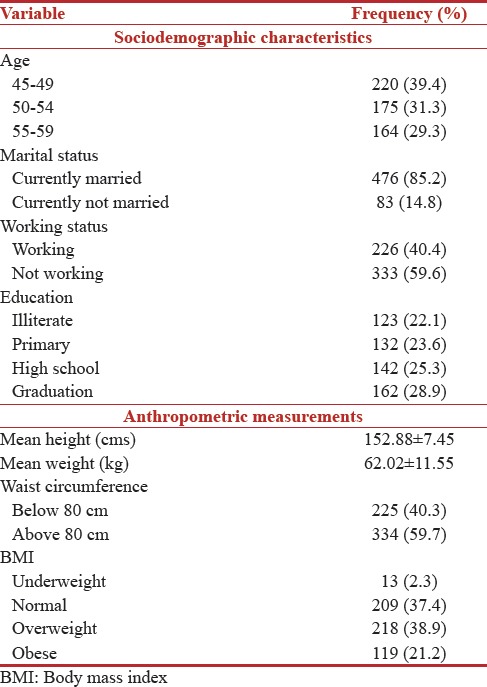
Table 2 describes the prevalence of risk factors especially lifestyle factors. It can be seen that a majority (64.7%) of the respondents had low level of physical activity and 35.3% of the respondents had moderate levels of physical activity. None of the respondents were involved in any form of vigorous physical activity. Majority of the respondents reported to consume some vegetable every day (66.5%); however, consumption of fruits was very rare. Consumption of fried and outside food was reported to be occasional in 61.9% respondents. Only a small percentage of 39.4 were involved in some form of physical activity at leisure time which mainly involves walking. Tobacco consumption was reported by 24.9% of the respondents, mostly in the form of Mishri application.
Table 2.
Frequency distribution of life style factors
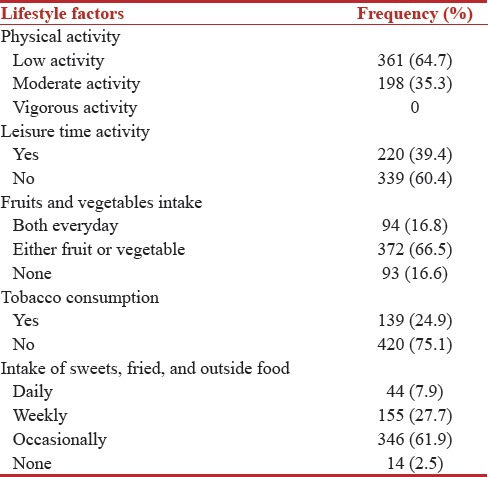
Table 3 describes the health status of the respondents. Many respondents reported the prevalence of chronic illness, or aches and pain and also functional limitations. Hypertension was reported by 125 (22.4%) respondents. The percentage of reporting of diabetes and osteoarthritis was found to be 14% and 7.9%, respectively. Knee pain (42%) was the frequently reported site of pain followed by low back pain (39.0%) in the respondents. About 63% of the respondents reported having difficulty in performing at least one activity of daily living which restricted their function. Difficulty in climbing stairs (50%), squatting (40.4%), bending (31.3%), rising from chair (18.8%), walking (16.8%), and last lifting 2–3 kgs weight (12.7%).
Table 3.
Frequency distribution of health parameters
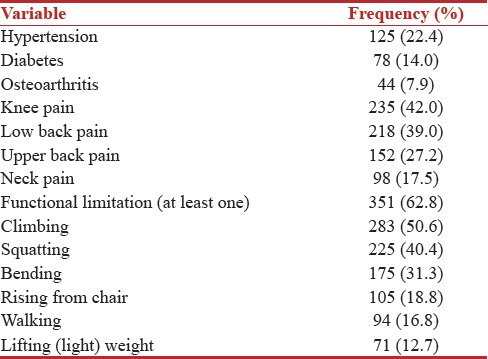
Table 4 shows results of Univariate analysis of the dependent and independent variables considered in the study. It reveals that significantly higher percentages of overweight and obese respondents were not working and stayed at home (P = 0.042). The percentage of respondents having normal weight decreased with age (P = 0.036). Increased BMI and waist circumference above 80 cm was significantly (P = 0.001) associated. Nearly, 48% of overweight and 30% obese reported waist circumference above 80 cm. A majority of overweight respondents did not participate in any leisure time activity (P = 0.032). It can be seen from the Table 2 that, consumption of fruits and vegetables was very low in women who were obese (P = 0.036). Consumption of sweets, fried food, and outside food was the highest in respondents who were overweight, but no statistical significance was found. Out of the 125 respondents who reported hypertension 44.8% were overweight and 28% were obese. Thus, obesity and hypertension were significantly associated (P = 0.013). The percentage of knee pain was higher in respondents who were overweight (36.6%) and obese (21.8%) at P = 0.029. The analysis reveals that the percentage of difficulty in performing daily activities was high among respondents who were overweight and obese. The percentage of respondents having difficulty in squatting was around 42.2% in overweight and 27.5% in obese respondent (P = 0.001). The analysis showed that higher percentage of overweight (43.6%) and obese (33%) respondents had difficulty in walking (P = 0.001). About 41.7% overweight and 25.1% obese and 39% overweight respondent had difficulty in climbing stairs (P = 0.004) and 39% of overweight and 30.5% obese respondents had difficulty in rising from chair (P = 0.040).
Table 4.
Association between body mass index category and other variables
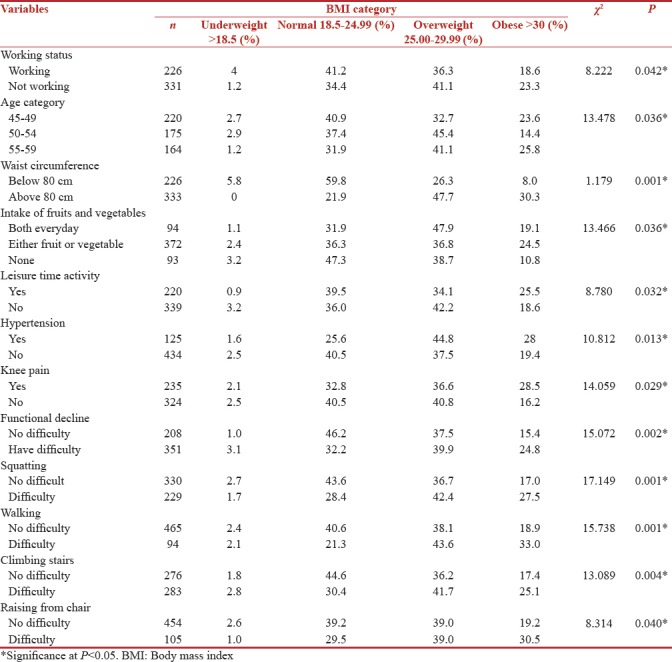
No statistical association was found between BMI and education levels, income levels, tobacco and alcohol consumption, physical activity level, diabetes, osteoarthritis, upper back pain, low back pain, and neck pain.
Table 5 shows the results of multiple logistic regressions performed using various variables with BMI. The current model (variance explained 59.209) consists of working status, high blood pressure, knee pain, squatting and walking. The analysis showed that odds of having high blood pressure, difficulty in squatting, and difficulty in walking among overweight women was 1.8 (95% confidence interval [CI]: 1.13 + 3.09, P = 0.015), 1.5 (95% CI: 1.00 + 2.49, P = 0.049), and 1.9 (95% CI: 1.08 + 3.69, P = 0.027), respectively more. The odds of having high blood pressure and difficulty in walking was 1.8 (95% CI: 1.05 + 3.30, P = 0.033) and 2.4 (95% CI: 1.23 + 4.67, P = 0.010) respectively more in obese women as compared to the women in normal weight category.
Table 5.
Association between overweight, obesity, and other variables
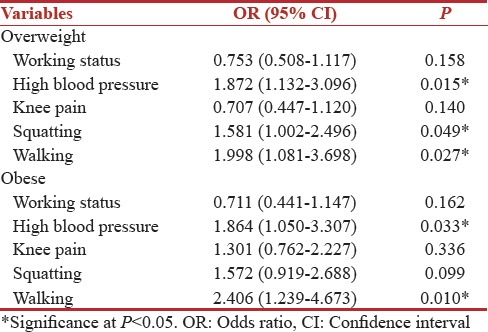
DISCUSSION
This study primarily focuses on obesity and associated factors in middle-aged women in the slum area. This section of the society is neglected in terms of interventions for noncommunicable disease or lifestyle modification intervention. India and other developing countries are undergoing rapid urbanization and changes in lifestyle. There is a shift in the pattern of morbidity from infectious diseases to noncommunicable diseases.[6] Locally prevailing conditions food choices, occupations, lifestyle change due to urbanization, may impact their life directly. The major finding of the study suggests a huge burden of obesity in the population. The prevalence of overweight and obesity in the study was found to be 38.9% and 21.2%, respectively. NFHS-4 reports 32.4% prevalence of women having BMI above 25.00 kg/m2 in Maharashtra;[5] the Figure represents the entire urban population. While the other studies reported obesity prevalence of 58.1% in the North [7] and 19.8% in the South of India.[8] Thus, a wide variation is reported in the studies. This study shows alarmingly high prevalence of obesity and overweight among women in slum. This is perhaps because the other studies include women of all age groups while this study focuses on a narrow age segment between 45 and 59 ages. Among respondents, the percentage of obesity was highest among 55–59 years (25.7%) followed by 45–49 years (23.6%). A study was done in Chennai [8] and North India [9] also found a significantly increasing trend of obesity with advancing age, the highest being above 50 years of age. Thus, the risk of obesity increases with age. Nearly, half that is 47% of women reported waist circumference more than 80 cm irrespective of their BMI, indicative of central obesity. This is an alarming finding as the risk of chronic conditions also increases with the age and increasing BMI.[4] The study highlights the need for population-based surveillance of obesity and implementation of effective interventions to control weight, especially during middle ages.
One of the risk factors for increased BMI is dietary practices. Consumption of fried/outside food was frequent as it is easily available within the slum area. It was affordable as compared to the cost of fruits in any urban market. The vegetable was consumed daily by two-third of the population, but it was often bought in a small quantity and shared with other members of the family. During the days of religious fasting, women preferred to buy a packet of potato chips than an orange or a papaya. Consumption of fruits was very low and as reported earlier intake of green leafy vegetables, other vegetables, and fruits were significantly inadequate in women.[10]
The physical activity assessment using IPAQ suggested that 64.7% women were leading a sedentary lifestyle and only 39.4% women reported to perform some form of activity, commonly being performing household chores, working as domestic help and maids and light work outside household. This finding is similar to the finding from Mumbai and Vellore [11,12] perhaps because women in slums have limited physical space, going out for walking or for exercising is not culturally/socially acceptable, and may give rise to safety issues. Sitting for long hours watching television, chatting with relatives and friends, siesta, were their leisure activities women were not very keen on taking up exercise. It is evident that moderate physical activity, like brisk walking may be beneficial for the improvement of quality of life.[6] Interventions to increase physical activity should be recommended to prevent increase in BMI.
The study also looks at health-related variables associated with overweight and obese women. Odds of being hypertensive were 1.8 times more in obese category. A study conducted in the same city Pune in the year 2011, found that hypertension was significantly higher in females with BMI more than 25.[13] Number of studies have demonstrated the association between aches and pains especially knee pain, low backache, and overweight and obese women.[14,15] The relation between obesity and pain in lower limbs especially knee is important as it gives rise to functional limitations. The knee joint is exposed to high compressive loads of body weight during walking and other activities causing pain, discomfort and ultimately functional limitation. Overall 62.8% women reported to have difficulty to perform at least one or more activities. The odds for difficulty in walking, squatting, climbing were more for overweight and obese women than normal weight women. The odds of having difficulty in walking was 2.4 times higher in women who were obese than their counterparts. This finding is similar to that of other studies.[16,17] These findings are indicative of multicomponent interventions for reducing increasing BMI in slum areas.
The findings of this study indicate a need for specific intervention strategy targeted towards urban slum women. A few studies done in the developed nations suggest that combined programs are more effective to reduce obesity than diet only or physical activity only programs.[18,19] These interventions have to be effective in terms of behavioral change. In a study done in India,[20,21] it was seen that the influence of a multilevel intervention for cardiovascular diseases improved the knowledge, but no change was observed in practices of middle-aged women in urban and rural India. This point out need for specific interventions targeting women in slum area.
Thus, the study shows that the prevalence of obesity is higher among women even in the low-income areas. There is dearth of literature regarding obesity in urban slum areas and interventions to reduce this. Therefore, the study indicates a need for specific interventions targeted to women in urban slum and inclusion of multicomponent intervention will prove to be beneficial at the community level.
Financial support and sponsorship
UGC-UPE-262[B][2].
Conflicts of interest
There are no conflicts of interest.
Acknowledgment
We would like to thank Ms. Anuprita Ahire and Ms. Amruta Kulkarni for their contribution in data collection.
REFERENCES
- 1.Tanumihardjo SA, Anderson C, Kaufer-Horwitz M, Bode L, Emenaker NJ, Haqq AM, et al. Poverty, obesity, and malnutrition: An international perspective recognizing the paradox. J Am Diet Assoc. 2007;107:1966–72. doi: 10.1016/j.jada.2007.08.007. [DOI] [PubMed] [Google Scholar]
- 2.HO. Double Burden of Malnutrition in Developing Countries. Food and Agricultural Association of the United Nations. 2006. [Last cited on 2018 Jan 10]. Available from: http://www.ftp.fao.org/docrep/fao/009/a0442e/a0442e01.pdf .
- 3.NFHS 4 National Family Health Survey 4 Fact sheet. [Last cited on 2018 Jan 01]. Available from: http://www.rchiips.org/NFHS/pdf/NFHS4/India.pdf .
- 4. [Last cited on 2017 Dec 18]. Available from: http://www.who.int/topics/obesity/en .
- 5.Nagarkar A, Gadhave S, Kulkarni S. Development and preliminary validation of a new scale to assess functional ability of older population in India. Arch Gerontol Geriatr. 2014;58:263–8. doi: 10.1016/j.archger.2013.10.002. [DOI] [PubMed] [Google Scholar]
- 6.Pradeepa R, Anjana RM, Joshi SR, Bhansali A, Deepa M, Joshi PP, et al. Prevalence of generalized & abdominal obesity in urban & rural india – The ICMR-INDIAB study (Phase-I) [ICMR- NDIAB-3] Indian J Med Res. 2015;142:139–50. doi: 10.4103/0971-5916.164234. [DOI] [PMC free article] [PubMed] [Google Scholar]
- 7.Girdhar S, Sharma S, Chaudhary A, Bansal P, Satija M. An epidemiological study of overweight and obesity among women in an urban area of north India. Indian J Community Med. 2016;41:154–7. doi: 10.4103/0970-0218.173492. [DOI] [PMC free article] [PubMed] [Google Scholar]
- 8.Anuradha R, Ravivarman G, Jain T. The prevalence of overweight and obesity among women in an urban slum of Chennai. J Clin Diagn Res. 2011;5:957–60. [Google Scholar]
- 9.Misra A, Pandey RM, Devi JR, Sharma R, Vikram NK, Khanna N, et al. High prevalence of diabetes, obesity and dyslipidaemia in urban slum population in northern India. Int J Obes Relat Metab Disord. 2001;25:1722–9. doi: 10.1038/sj.ijo.0801748. [DOI] [PubMed] [Google Scholar]
- 10.Ranasinghe C, Shettigar PG, Garg M. Dietary intake, physical activity and body mass index among postmenopausal women. J Midlife Health. 2017;8:163–9. doi: 10.4103/jmh.JMH_33_17. [DOI] [PMC free article] [PubMed] [Google Scholar]
- 11.Taka T, Tragler A. Prevalence of obesity and the factors influencing it among women in a slum of mumbai. IOSR J Diagn Med Sonogr. 2014;13:76–9. [Google Scholar]
- 12.Jayamani V, Gopichandran V, Lee P, Alexander G, Christopher S, Prasad JH, et al. Diet and physical activity among women in urban and rural areas in south India: A Community based comparative survey. J Family Med Prim Care. 2013;2:334–8. doi: 10.4103/2249-4863.123782. [DOI] [PMC free article] [PubMed] [Google Scholar]
- 13.Gothankar JS. Prevalence of obesity and its associated co-morbidities amongst adults. Natl J Community Med. 2011;2:221–4. [Google Scholar]
- 14.Bindawas SM. Relationship between frequent knee pain, obesity, and gait speed in older adults: Data from the osteoarthritis initiative. Clin Interv Aging. 2016;11:237–44. doi: 10.2147/CIA.S100546. [DOI] [PMC free article] [PubMed] [Google Scholar]
- 15.Vincent HK, Lamb KM, Day TI, Tillman SM, Vincent KR, George SZ, et al. Morbid obesity is associated with fear of movement and lower quality of life in patients with knee pain-related diagnoses. PM R. 2010;2:713–22. doi: 10.1016/j.pmrj.2010.04.027. [DOI] [PubMed] [Google Scholar]
- 16.Agrawal P, Gupta K, Mishra V, Agrawal S. The psychosocial factors related to obesity: A Study among overweight, obese, and morbidly obese women in India. Women Health. 2015;55:623–45. doi: 10.1080/03630242.2015.1039180. [DOI] [PMC free article] [PubMed] [Google Scholar]
- 17.Daviglus ML, Liu K, Yan LL, Pirzada A, Garside DB, Schiffer L, et al. Body mass index in middle age and health-related quality of life in older age: The Chicago heart association detection project in industry study. Arch Intern Med. 2003;163:2448–55. doi: 10.1001/archinte.163.20.2448. [DOI] [PubMed] [Google Scholar]
- 18.Birnie K, Thomas L, Fleming C, Phillips S, Sterne JA, Donovan JL, et al. An evaluation of a multi-component adult weight management on referral intervention in a community setting. BMC Res Notes. 2016;9:104. doi: 10.1186/s13104-016-1901-1. [DOI] [PMC free article] [PubMed] [Google Scholar]
- 19.Larsen KT, Huang T, Ried-Larsen M, Andersen LB, Heidemann M, Møller NC, et al. Amulti-component day-camp weight-loss program is effective in reducing BMI in children after one year: A Randomized controlled trial. PLoS One. 2016;11:e0157182. doi: 10.1371/journal.pone.0157182. [DOI] [PMC free article] [PubMed] [Google Scholar]
- 20.Pandey RM, Agrawal A, Misra A, Vikram NK, Misra P, Dey S, et al. Population-based intervention for cardiovascular diseases related knowledge and behaviours in Asian Indian women. Indian Heart J. 2013;65:40–7. doi: 10.1016/j.ihj.2012.12.019. [DOI] [PMC free article] [PubMed] [Google Scholar]
- 21.Daivadanam M, Absetz P, Sathish T, Thankappan KR, Fisher EB, Philip NE, et al. Lifestyle change in kerala, india: Needs assessment and planning for a community-based diabetes prevention trial. BMC Public Health. 2013;13:95. doi: 10.1186/1471-2458-13-95. [DOI] [PMC free article] [PubMed] [Google Scholar]


